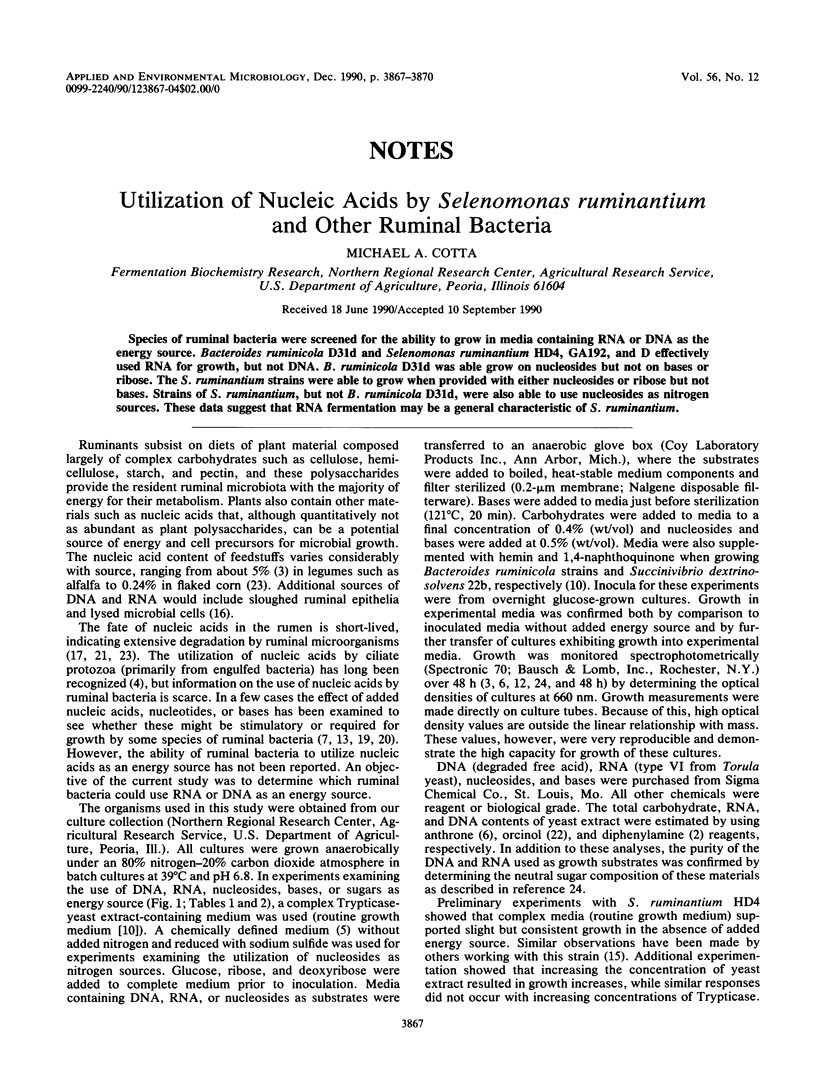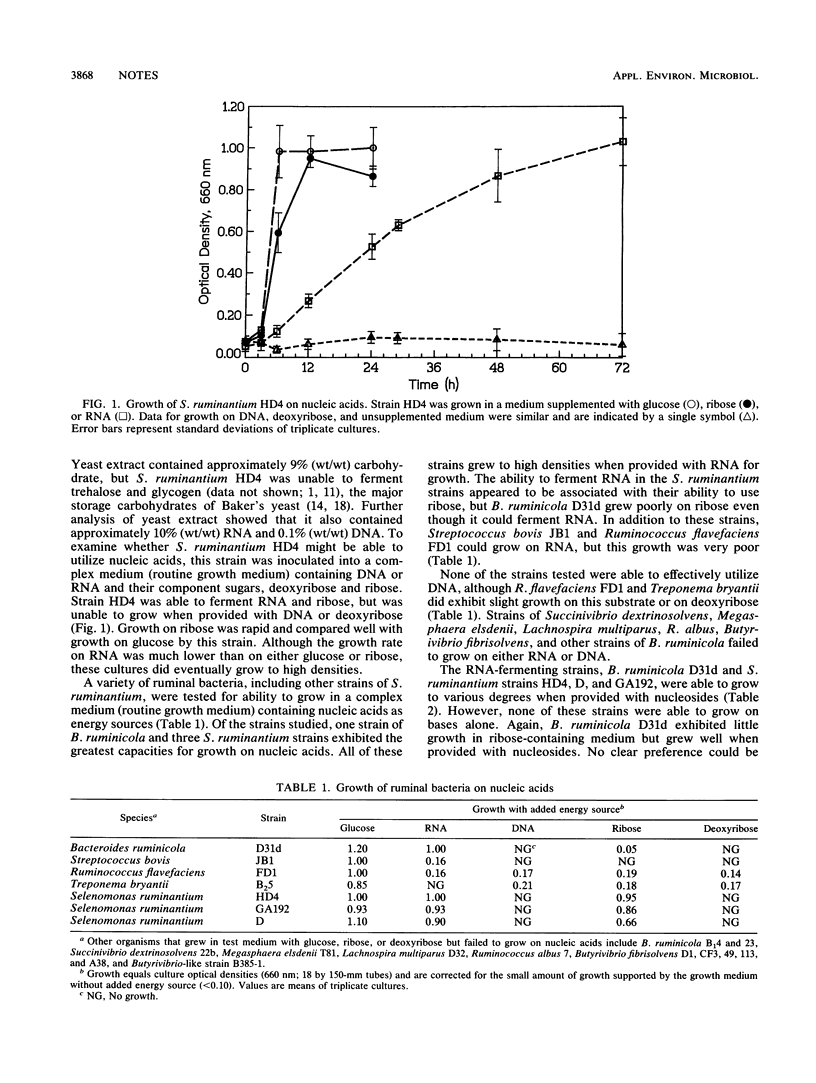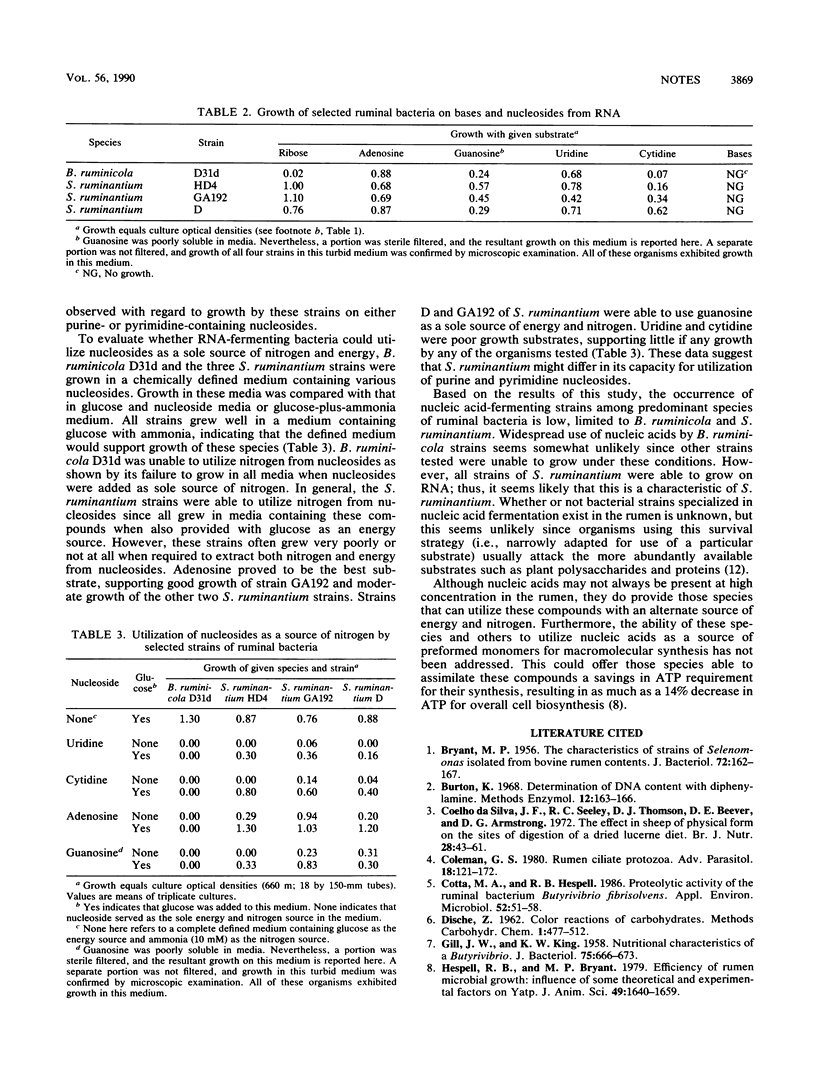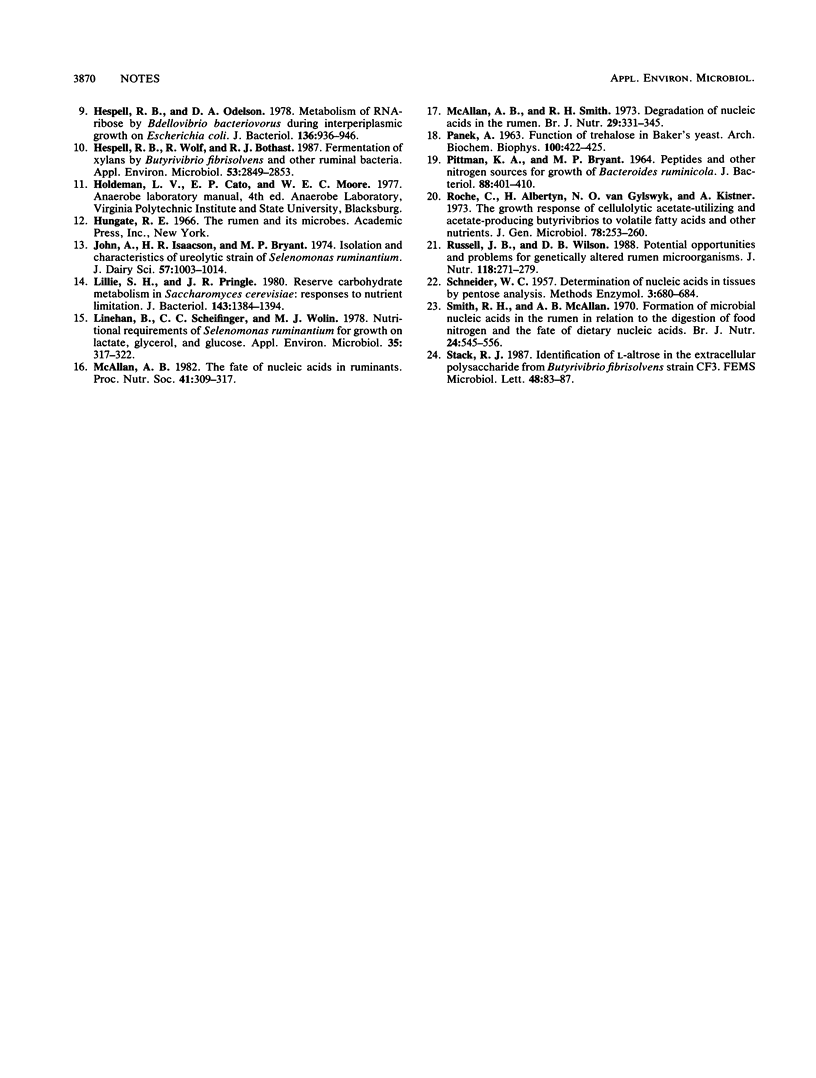Abstract
Species of ruminal bacteria were screened for the ability to grow in media containing RNA or DNA as the energy source. Bacteroides ruminicola D31d and Selenomonas ruminantium HD4, GA192, and D effectively used RNA for growth, but not DNA. B. ruminicola D31d was able grow on nucleosides but not on bases or ribose. The S. ruminantium strains were able to grow when provided with either nucleosides or ribose but not bases. Strains of S. ruminantium, but not B. ruminicola D31d, were also able to use nucleosides as nitrogen sources. These data suggest that RNA fermentation may be a general characteristic of S. ruminantium.
Full text
PDF



Selected References
These references are in PubMed. This may not be the complete list of references from this article.
- BRYANT M. P. The characteristics of strains of Selenomonas isolated from bovine rumen contents. J Bacteriol. 1956 Aug;72(2):162–167. doi: 10.1128/jb.72.2.162-167.1956. [DOI] [PMC free article] [PubMed] [Google Scholar]
- Coelho da Silva J. F., Seeley R. C., Thomson D. J., Beever D. E., Armstrong D. G. The effect in sheep of physical form on the sites of digestion of a dried lucerne diet. 2. Sites of nitrogen digestion. Br J Nutr. 1972 Jul;28(1):43–61. doi: 10.1079/bjn19720007. [DOI] [PubMed] [Google Scholar]
- Coleman G. S. Rumen ciliate protozoa. Adv Parasitol. 1980;18:121–173. doi: 10.1016/s0065-308x(08)60399-1. [DOI] [PubMed] [Google Scholar]
- Cotta M. A., Hespell R. B. Proteolytic activity of the ruminal bacterium Butyrivibrio fibrisolvens. Appl Environ Microbiol. 1986 Jul;52(1):51–58. doi: 10.1128/aem.52.1.51-58.1986. [DOI] [PMC free article] [PubMed] [Google Scholar]
- GILL J. W., KING K. W. Nutritional characteristics of a Butyrivibrio. J Bacteriol. 1958 Jun;75(6):666–673. doi: 10.1128/jb.75.6.666-673.1958. [DOI] [PMC free article] [PubMed] [Google Scholar]
- Hespell R. B., Bryant M. P. Efficiency of rumen microbial growth: influence of some theoretical and experimental factors of YATP. J Anim Sci. 1979 Dec;49(6):1640–1659. doi: 10.2527/jas1979.4961640x. [DOI] [PubMed] [Google Scholar]
- Hespell R. B., Odelson D. A. Metabolism of RNA-ribose by Bdellovibrio bacteriovorus during intraperiplasmic growth on Escherichia coli. J Bacteriol. 1978 Dec;136(3):936–946. doi: 10.1128/jb.136.3.936-946.1978. [DOI] [PMC free article] [PubMed] [Google Scholar]
- Hespell R. B., Wolf R., Bothast R. J. Fermentation of xylans by Butyrivibrio fibrisolvens and other ruminal bacteria. Appl Environ Microbiol. 1987 Dec;53(12):2849–2853. doi: 10.1128/aem.53.12.2849-2853.1987. [DOI] [PMC free article] [PubMed] [Google Scholar]
- John A., Isaacson H. R., Bryant M. P. Isolation and characteristics of a ureolytic strain of Selenomonas ruminatium. J Dairy Sci. 1974 Sep;57(9):1003–1014. doi: 10.3168/jds.s0022-0302(74)85001-0. [DOI] [PubMed] [Google Scholar]
- Lillie S. H., Pringle J. R. Reserve carbohydrate metabolism in Saccharomyces cerevisiae: responses to nutrient limitation. J Bacteriol. 1980 Sep;143(3):1384–1394. doi: 10.1128/jb.143.3.1384-1394.1980. [DOI] [PMC free article] [PubMed] [Google Scholar]
- Linehan B., Scheifinger C. C., Wolin M. J. Nutritional Requirements of Selenomonas ruminantium for Growth on Lactate, Glycerol, or Glucose. Appl Environ Microbiol. 1978 Feb;35(2):317–322. doi: 10.1128/aem.35.2.317-322.1978. [DOI] [PMC free article] [PubMed] [Google Scholar]
- McAllan A. B., Smith R. H. Degradation of nucleic acids in the rumen. Br J Nutr. 1973 Mar;29(2):331–345. doi: 10.1079/bjn19730107. [DOI] [PubMed] [Google Scholar]
- McAllan A. B. The fate of nucleic acids in ruminants. Proc Nutr Soc. 1982 Sep;41(3):309–317. doi: 10.1079/pns19820046. [DOI] [PubMed] [Google Scholar]
- PITTMAN K. A., BRYANT M. P. PEPTIDES AND OTHER NITROGEN SOURCES FOR GROWTH OF BACTEROIDES RUMINICOLA. J Bacteriol. 1964 Aug;88:401–410. doi: 10.1128/jb.88.2.401-410.1964. [DOI] [PMC free article] [PubMed] [Google Scholar]
- Roché C., Albertyn H., van Gylswyk N. O., Kistner A. The growth response of cellulolytic acetate-utilizing and acetate-producing butyruvibrios to volatile fatty acids and other nutrients. J Gen Microbiol. 1973 Oct;78(2):253–260. doi: 10.1099/00221287-78-2-253. [DOI] [PubMed] [Google Scholar]
- Russell J. B., Wilson D. B. Potential opportunities and problems for genetically altered rumen microorganisms. J Nutr. 1988 Feb;118(2):271–279. doi: 10.1093/jn/118.2.271. [DOI] [PubMed] [Google Scholar]
- Smith R. H., McAllan A. B. Nucleic acid metabolism in the ruminant. 2. Formation of microbial nucleic acids in the rumen in relation to the digestion of food nitrogen, and the fate of dietary nucleic acids. Br J Nutr. 1970 Jun;24(2):545–556. doi: 10.1079/bjn19700052. [DOI] [PubMed] [Google Scholar]


